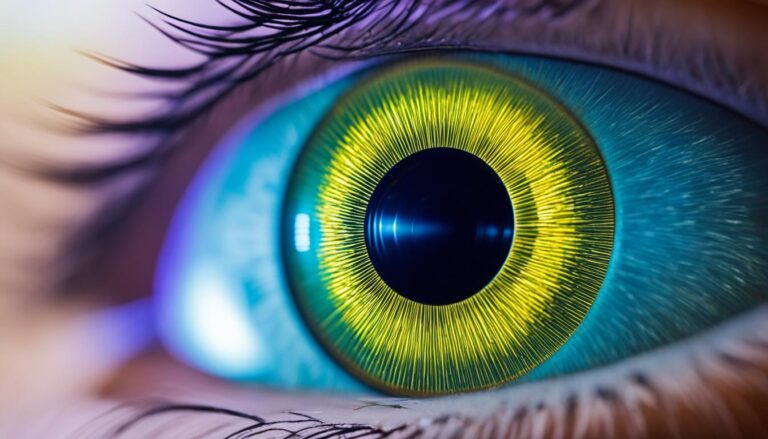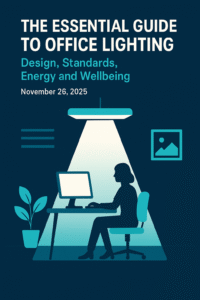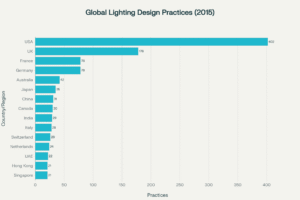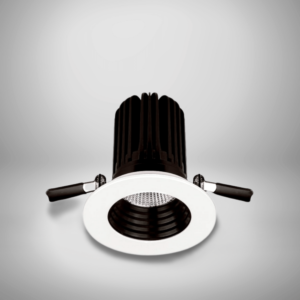Did you know that LED luminaires can last up to 50,000 hours? This is a stark contrast to traditional bulbs, which only last about 1,000 hours. At Lumenloop, we understand the importance of knowing how long LED lights last. This knowledge is key to choosing energy-efficient and sustainable lighting.
Exploring the world of LED bulbs reveals their superiority not just in lifespan but also in energy efficiency. They use 75% less energy than traditional lighting. This means the benefits of LED bulbs go beyond just lasting longer; they help the environment too.
Let’s dive into seven crucial facts about LED light longevity. We’ll see why adopting this technology is vital for our homes and businesses. These insights will guide us in making choices that protect our planet.
The Efficiency of LED Lighting
Exploring the your lighting reveals the pivotal role of LED efficiency. LEDs stand out when compared to incandescent and fluorescent bulbs, showcasing their superior functionality and performance. But what about LED bulbs compared to luminaires?
LED Bulbs vs Luminaires
The primary difference between LED bulbs and LED luminaires lies in their design and application. An LED bulb is a direct replacement for traditional light sources like incandescent, halogen, or compact fluorescent bulbs, fitting into standard sockets such as E27, E14, and GU10. These bulbs mimic the shape and appearance of the lamps they replace and come with built-in drivers. Typically, their lifetimes range from 15,000 to 35,000 hours, with an average expectation that 50% of the bulbs will still operate at 70% of their original brightness by the end of this period.
Lifetimes vary between manufacturers and lamp types, but are normally 15,000 to 35,000 hours. This is specified as an average lifetime and means that up to 50% of the light sources will have failed (B50) by this time and that the remaining light sources will continue to function with at least 70% of their original brightness (L70). The calculation assumes an ambient temperature of 25°C.
An LED luminaire is a complete luminaire (unit) that can be connected to the mains supply via a remote driver. In addition to the housing, it contains an LED module and a reflector and lens, as well as a heat sink to transfer heat away from the diodes. The driver usually determines whether the brightness of the luminaire can be adjusted (dimmed). The advantage of luminaires is that they are designed to outlast LED bulbs with a much larger heatsink, a chunk of metal (usually alluminium) designed to draw heat away from the precious LED. The driver is also usually remote which means it is more thermally efficient since these drivers can be located away from the LED, once again causing less stress/heat buildup on the LED. Luminaires are generally more expensive but worth the cost since you will have to replace them less often that an LED bulb.
The lifetime varies between manufacturers and luminaire types. It’s most often specified as a usable lifetime, stating the number of hours with at least 70% of the original brightness (L70) and the number of hours after which only 10% of the luminaires have failed completely (B10).
LEDs Compared to Incandescent and fluorecents
LEDs significantly outperform incandescent and fluorescent bulbs in terms of energy efficiency. They can last from 20,000 to 100,000 hours, far exceeding the lifespan of traditional bulbs. In contrast, incandescent bulbs inefficiently convert energy, wasting about 90% as heat. LEDs, on the other hand, convert 95% of their energy into light, losing only 5%, making them up to 80% more efficient than fluorescent bulbs.
From a safety standpoint, LEDs operate at a lower temperature, reducing the risk of fires associated with incandescent bulbs. Their design ensures light is directed effectively, limiting emissions to 180 degrees, and maximising usable light output.
The Energy Savings of LED Lights
Switching to LED lighting results in substantial energy savings for both households and businesses. LEDs use about 75% less energy than incandescent lights and can save up to 25-80% compared to fluorescent bulbs. This energy reduction not only lowers electricity bills but also diminishes the carbon footprint, as lighting represents around 20% of global energy consumption.
High-quality LED luminaires can endure up to 50 times longer than incandescent bulbs. This extended lifespan means fewer replacements and maintenance, leading to reduced costs over time. Thus, the energy efficiency of LEDs offers not just immediate savings but also long-term financial benefits.
| Lighting Type | Energy Efficiency | Average Lifespan | Heat Emission |
|---|---|---|---|
| Incandescent | ~10-20 lm/W | 1,000 hours | High |
| Fluorescent | ~35-100 lm/W | 7,000-15,000 hours | Moderate |
| LED | ~80-170 lm/W | 20,000-50,000 hours | Low |
Understanding LED Technology
Light Emitting Diodes, or LEDs, have revolutionised our lighting world with their unmatched efficiency and durability. These semiconductor devices produce light when an electric current flows through them. Over time, LED technology has seen substantial advancements, boosting their brightness, colour range, and versatility. This evolution not only enriches the user experience but also extends their lifespan, making them a top choice for various lighting applications.
What are Light Emitting Diodes?
LEDs are solid-state lighting solutions, not dependent on gas or filaments for illumination. When an electric current traverses the semiconductor material in an LED, it liberates energy as photons or light. This process enables LEDs to boast an energy efficiency of 80 to 90%, far surpassing traditional lighting like incandescent bulbs. Such a leap in energy efficiency supports environmental sustainability and reduces electricity costs for building operators.
How LED Technology Has Evolved Over Time
Since their inception in the 1960s, LEDs have witnessed steady advancements, significantly boosting their capabilities. Initially, they were mainly used for indicators and displays due to their limited brightness and colour palette. However, today, they are integral to general lighting, TV backlighting, and automotive lighting, among other applications. A typical luminaire can endure up to 50,000 hours, while some high-end models, like the Nichia LED, can last as long as 200,000 hours. This longevity far exceeds traditional incandescent bulbs, which usually last between 750 to 2,000 hours.
The lifespan of LEDs is contingent upon factors such as component quality and manufacturing standards. Reputable brands like Samsung and Seoul back their products with LM80 and TM21 testing reports, underscoring their dedication to quality. Conversely, inferior LEDs may not meet their advertised lifespans. Ongoing research and development in LED technology promise further enhancements, ensuring longevity, dependability, and superior light quality for consumers.
LED Light Longevity: The Lifespan of LED Luminaires
Understanding the lifespan of LED luminaires is crucial for making smart lighting choices. Typically, they last between 20,000 to 50,000 hours. Some claim LEDs can last up to 25 years under ideal conditions. However, actual lifespan depends on how often you use them. For example, an LED used 7 hours a day can last almost 9.7 years, which meets most users’ expectations. If you’re wondering how luminaires are tested to achieve these ratings, it involves switching them on and off many, many times to induce as much stress on them as possible.
Factors Influencing LED Lifespan
Although there are several factors affect LED lifespan, impacting how long they last. The most common cause we see for failures is heat. Environmental conditions, like humidity and temperature are crucial. Poor thermal management can dramatically shorten their life, as excessive heat is a common cause of failure. It’s important to ensure power source compatibility by matching wattages and voltage ratings to avoid damage. Mixing different lighting technologies in one fixture can also reduce LED lifespan.
Turning off lights when not in use helps extend LED bulb life and cuts energy costs. LEDs can keep at least 70% of their brightness over their lifespan. We highly recommend a form of lighting control to automate the process. Understanding these factors helps consumers choose the right lighting, ensuring their LEDs last longer.
Maximising LED Luminaire Lifespan
To ensure our LED luminairesreach their maximum lifespan, proper installation and usage are key. By adhering to specific guidelines, we can extend their lifespan, benefiting from their advantages for a longer time.
Proper Installation and Usage Tips
First, it’s vital to install LED fixtures in locations that ensure good airflow. This prevents overheating, which can cut their lifespan short. Additionally, opting for high-quality LED fixtures aids in effective heat management, boosting the bulb’s lifespan.
Maintenance Practices for Extended Lifespan
Regular maintenance is essential for prolonging LED light lifespan. Cleaning fixtures to remove dust and debris is crucial, as dirt can lead to heat retention and reduced light output. Regular inspections help spot early signs of wear or damage, allowing for prompt action. Using surge protectors during storms or electrical issues also protects our LED lights, promoting their longevity.
Advancements in LED Longevity
Recent technological strides have transformed our understanding and use of LED lighting. The focus on improving longevity is essential, as it offers significant benefits for both operational efficiency and environmental impact. Key areas in this development include the role of efficient drivers and innovations in LED chip technology.
The Role of Efficient Drivers
Efficient drivers are crucial in maximising the performance of LED systems. They cut down energy loss and enhance the overall durability of lighting solutions. By managing power supply effectively, these drivers reduce heat generation, a common cause of early failure in traditional lighting.
For example, one key consideration is the drive current (how much power you’re running through the driver). Two identical luminaires can have very significant differences in lifespan if one is running at 1050mA and the other is 350mA. It’s always best to opt for the lower drive current if possible.
The advancements in LED longevity depend heavily on these efficient drivers. They ensure optimal performance for longer periods, making them integral to the longevity of LEDs.
Innovations in LED Chip Technology
Innovative LED chip technology has changed the landscape of lighting design with a significant effect on LED light longevity. Modern chips can handle higher temperatures and stresses, leading to better longevity and efficiency. The development of chips that offer a wide spectrum of wavelengths enables precise control over light intensity.
This makes them perfect for applications like fluorescence microscopy. These advancements mean LEDs are not just more resilient but also deliver consistent performance across different environments.
LED vs. Traditional Lighting: Total Cost of Ownership
When looking at the switch from traditional to LED lighting, it’s essential to consider the total cost of ownership. This includes energy savings, longevity, and maintenance costs. LEDs may seem pricier at first but are more cost-effective over time due to their efficiency and long life. This is especially relevant to why you should choose LED luminaires over LED bulbs.
Why Luminaires Are Worth the Investment
LED luminaires stand out for their low energy use. Unlike incandescent bulbs, which waste most energy as heat, LEDs convert 50-200 lumens per watt into light. This means LEDs use much less energy to produce the same light as traditional bulbs. This efficiency leads to lower electricity bills, as lighting is a significant part of global energy use. Switching to LEDs can save a lot of money, making them a smart choice for both homes and businesses.
Understanding the Long-Term Financial Benefits
LED luminaires last much longer, from 25,000 to 50,000 hours, reducing the need for replacements. Traditional bulbs like incandescent and halogen bulbs don’t last as long, needing more frequent replacements. This makes LEDs a better choice for durability. Businesses switching to LEDs can save a lot each year, from £2,342 to £13,914, and over five years, from £14,299 to £84,395.
| Lighting Type | Average Lifespan (Hours) | Energy Efficiency (Lumens per Watt) | Total Cost of Ownership |
|---|---|---|---|
| LED | 25,000 – 50,000 | 50 | Lowest |
| CFL | 6,000 – 15,000 | 53.3 | Low |
| Halogen | 2,000 – 4,000 | 14.5 | Medium |
| Incandescent | 750 – 1,000 | 13 | Highest |
In summary, LED luminaires are better than traditional lighting in energy efficiency and cost savings. They offer lower operational costs and longer lifespans. Seeing lighting as an investment helps in making the right choice for a sustainable future.
Environmental Impact of LED Lighting
As we face the challenges of climate change, the environmental benefits of LED lighting stand out. This technology offers significant advantages for eco-friendly lighting solutions. It plays a crucial role in reducing our carbon footprint and supporting a greener future.
The Sustainability of LED Technology
LED technology’s energy efficiency is important sustainability. It uses about 80% less electricity than traditional bulbs, which means a huge cut in greenhouse gas emissions. With a lifespan of 50,000 to 100,000 hours, luminaires last longer than other bulbs, reducing the need for replacements and waste.
- LED lighting does not contain hazardous materials like mercury, commonly found in fluorescent bulbs.
- Manufacturers often use recyclable materials, promoting a circular economy that conserves resources.
- Innovative designs prevent light pollution by focusing light on intended areas, thus enhancing sustainability.
Energy-Efficient Lighting for a Greener Future
Switching to energy-efficient lighting is vital for a greener planet. By choosing LED lighting, organisations follow dark-sky regulations and cut down on waste. This change benefits future generations by creating cleaner environments and saving energy.
| Lighting Type | Average Lifespan (Hours) | Energy Consumption Reduction | Carbon Emission Reduction |
|---|---|---|---|
| LED | 50,000 – 100,000 | 80% | Significant |
| Incandescent | 1,000 | – | – |
| Fluorescent | 7,000 – 15,000 | – | – |
LED technology helps us make a positive impact on sustainability goals. It ensures we choose energy-efficient lighting that benefits our planet.
Consumer Misconceptions About LED Longevity
Many individuals harbour misconceptions about LED lifespan which can influence their purchasing decisions. It’s essential to understand the facts about LED technology to make informed choices. A common myth is that all LED bulbs are equally durable and long-lasting, especially when comparing cheaper options with premium ones. A similar myth is that LED bulbs last just as long as LED luminaires – this simply is not the case.
Debunking Myths About LED Lifespan
LED luminaires stand out for their exceptional performance. They typically last between 15 to 20 years, significantly reducing the need for replacements compared to traditional light sources. The initial cost of LED products can be a point of confusion. Although they may appear more expensive at first, the long-term energy savings make up for this. In fact, switching to long-lasting LED luminaires can lead to savings of up to £140 annually on energy bills.
Understanding the Importance of Quality in LED Products
Not all LED bulbs or luminaires offer the same level of performance. The quality in LED products is vital in determining their lifespan and energy efficiency. For example, luminaires with a Colour Rendering Index (CRI) of 90 or above provide superior colour quality, unlike lower-quality luminaires or LED bulbs which may have a CRI of 80. Brands like Philips and Lumenloop use durable components and advanced technology, ensuring their products last longer and perform better. Investing in high-performance LED luminaires not only guarantees reliability but also supports sustainability in our daily lives.
| Aspect | LED Luminaires | Traditional Bulbs |
|---|---|---|
| Lifespan | 20,000 – 100,000 hours | 1,000 hours (incandescent) |
| Energy Consumption | Up to 85% less energy | Conventional energy use |
| Instant Brightness | Yes | Requires warm-up time (especially CFLs) |
| Heat Emission | Low heat output | High heat output |
| Environmental Impact | Mercury-free, recyclable | Contains hazardous materials |
Conclusion
Understanding the longevity of LED lights is important when choosing sustainable lighting options. Quality LED luminaires can last from 50,000 to 100,000 hours, significantly outlasting LED bulbs or traditional bulbs. This means they offer not just longer life but also lower maintenance costs and up to 80% energy savings.
Proper usage and maintenance can enhance the benefits of LED lighting. There are many variables to consider when selecting the right luminaire. Choosing high-quality LEDs is a step towards a sustainable future.
Lumenloop is dedicated to improving lighting quality and caring for the planet by elimating e-waste. By choosing durable, energy-efficient luminaires, we can all enjoy reliable lighting for years.
FAQ
How long do luminaires typically last?
LED luminaires are known for their longevity, often lasting between 50,000-100,000 hours.
What factors influence the longevity of LED lights?
The lifespan of luminaires is significantly impacted by several factors. These include the quality of components, how often they are used, thermal management, drive current and environmental conditions.
How can we maximise the lifespan of LED bulbs?
Ensuring proper installation and avoiding spaces that hinder ventilation are crucial. Regular maintenance, such as cleaning and inspecting connections, also extends their life.
Are luminaires more energy-efficient than LED bulbs?
Indeed, luminaires outperform LED, incandescent and fluorescent bulbs in energy efficiency. They use energy more effectively, requiring significantly less wattage to produce the same amount of light. This is why they are measured in lumens and not in watts.
What advancements have been made in LED longevity technology?
Recent advancements include the creation of more efficient drivers and innovative LED chip designs. These improvements enhance durability and resilience to high temperatures, thereby extending LED lighting’s lifespan.
Why is the total cost of ownership for LED lighting lower?
Although luminaires may initially cost more, their extended lifespan and energy efficiency lead to fewer replacements and lower maintenance costs. This makes them much more cost-effective over time.
What environmental benefits do LEDs offer?
LEDs reduce greenhouse gas emissions, lessen the strain on natural resources, and do not contain hazardous materials like mercury, promoting sustainable lighting solutions.
What are common misconceptions about LED light longevity?
A prevalent misconception is that all luminaires or LED bulbs are equally durable, regardless of price. However, the actual lifespan and reliability are directly tied to the quality of materials and technology used. Another misconception is that LED bulbs are just as effective as luminaires, which is not the case.
How can we choose high-quality LED products?
Opt for luminaires that focus on high-performance components which can be recycled and provide a warranty or guarantee. These are strong indicators of product quality and longevity.












